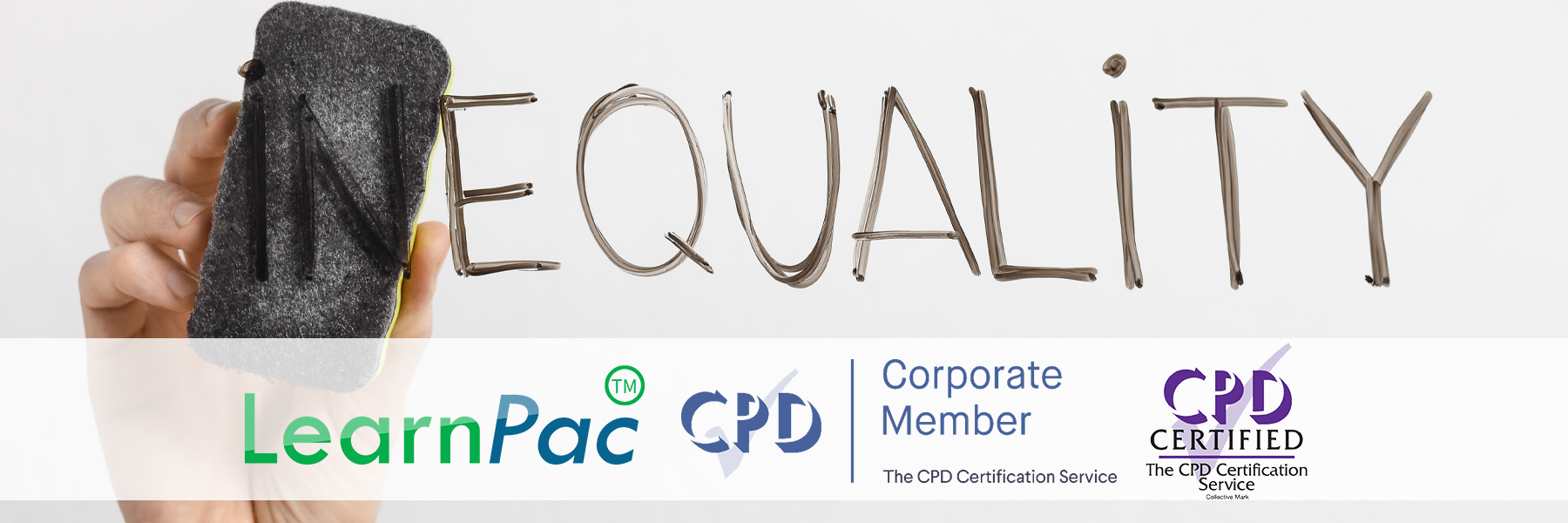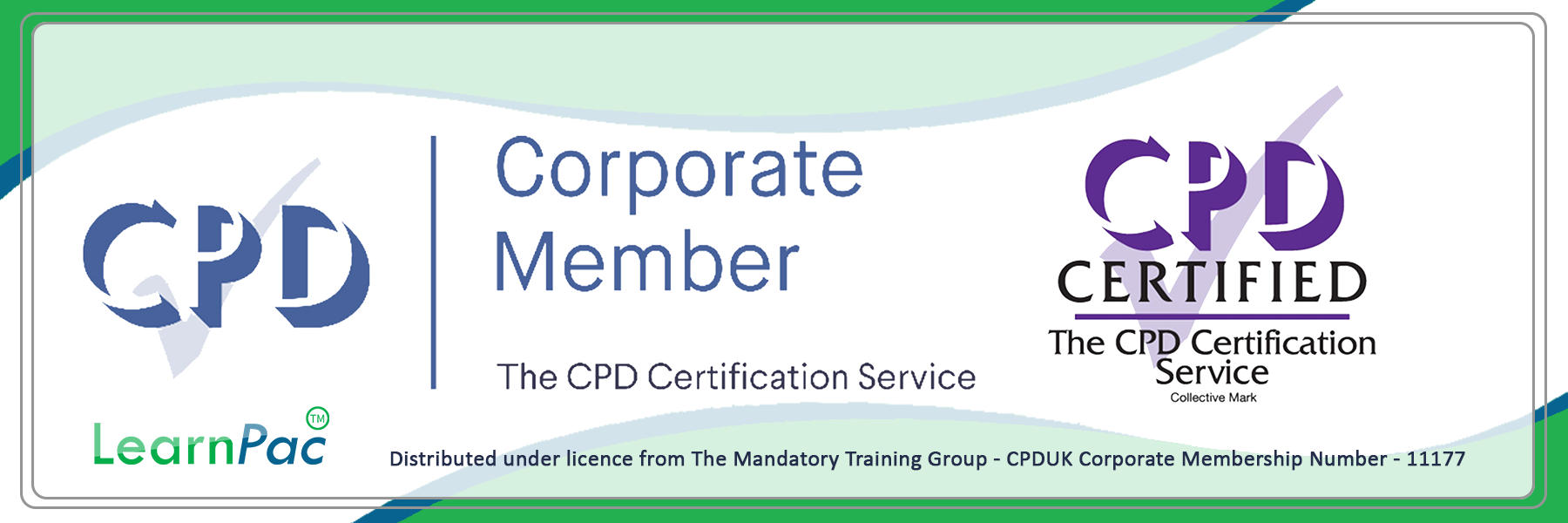Equality and Diversity - E-Learning Courses - CPDUK Accredited

Equality and Diversity- E-Learning Courses with Certificates – CPDUK Accredited.
LearnPac Systems is the leading UK provider of accredited statutory and mandatory training courses for all sectors, including health and social care, education, local government, private and charity sectors.
Equality and diversity e-Learning courses includes preventing harassment, working as part of a diverse team, and providing assistance to those with complex needs. Health and social care employees encounter individuals from a wide range of backgrounds throughout the course of their work.
Our equality and diversity e-Learning courses can benefit an organisation by helping to prevent civil rights violations, increasing the inclusion of different identity groups, and promoting better teamwork.
Browse our Equality and Diversity - E-Learning Courses
Equality and Diversity: Frequently Asked Questions and Answers
Equality and Diversity – E-Learning Courses with Certificates – CPDUK Accredited – LearnPac Systems UK.
Here at LearnPac Systems, we receive many questions about equality and diversity. We have provided answers to the most frequently asked questions about equality and diversity.
Click on the text below to see the answers to the Frequently Ask Questions about Equality and Diversity.
Equality is about ensuring everybody has equal opportunities, and is not treated differently or discriminated against because of their characteristics. Diversity is about taking all the differences between people and groups of people, setting a positive value on those differences.
LearnPac Systems is the leading UK provider of accredited statutory and mandatory training courses for all sectors, including health and social care, education, local government, private and charity sectors.
Click here for Equality, Diversity and Human Rights – Online Course – CPDUK Accredited
Equality and diversity refers to “promoting equality of opportunity for all through diversity and giving each individual the chance to achieve their potential, free from prejudice and discrimination”.
LearnPac Systems is the leading UK provider of accredited statutory and mandatory training courses for all sectors, including health and social care, education, local government, private and charity sectors.
Click here for CSTF Equality and Diversity and Human Rights – Level 1
Equality is about equal opportunities and protecting people from being discriminated against, while diversity is about recognising, respecting and valuing differences in people. Meanwhile, inclusion refers to an individual’s experience within the workplace, in the broader society, and the extent to which they feel valued and included.
Equality, diversity and inclusion are three concepts that help create a fair society where everyone gets equal opportunities.
Diversity is the study of one or more groups based on culture, race, ethnicity, gender, gender identity, sexual orientation, class, disability, religion, age, immigration, or geopolitical power.
LearnPac Systems is the leading UK provider of accredited statutory and mandatory training courses for all sectors, including health and social care, education, local government, private and charity sectors.
Click here for Equality, Diversity and Inclusion – Level 2 – Online Course – CPD Accredited
Diversity includes everything that we are and what we are not. It encompasses all those differences that make us unique, such as race, colour, ethnicity, language, nationality, sexual orientation, religion, gender, socioeconomic status and age, as well as physical and mental ability.
We can promote equality and diversity by:
- Treating all staff and students fairly
- Creating an inclusive culture for everyone
- Ensuring equal access to opportunities to enable students to participate in the learning process fully
- Allowing all staff and students to develop to their full potential.
Equality and diversity intends to ensure that everyone has access to the same opportunities and the same, fair treatment. If you actively promote equality and diversity and have the policy to match, your business will thrive. Thus, people of all backgrounds can come together and achieve success.
Equality in the workplace means that all employees have access to equal opportunities and peripherals regardless of age, gender, race, disability, sexual orientation, religious beliefs, or class. Diversity means that business and companies welcome people from various backgrounds.
Cultural diversity is when population differences are represented well within a community. These include race, ethnicity, age, ability, language, nationality, socioeconomic status, gender, religion, or sexual orientation. Cultural diversity has become a hot button issue when applied to the workplace.
The following factors are the benefits of a culturally diverse workplace:
- Increased productivity
- Improved creativity
- Increased profits
- Improved employee engagement
- Reduced employee turnover
- Improved company reputation
- A broader range of skills
- Improved cultural insights.
Providing training, guidance, development and even job shadowing or mentoring on a nondiscriminatory basis are examples of equal opportunities in the workplace.
Equality means “the state of being equal.” It is one of the ideals of a democratic society. The fight to attain different kinds of equality, like racial equality, gender equality, or equality of opportunity between rich and poor, is usually linked with progress toward the ideal of everyone being genuinely equal.
These are the common barriers to equality of opportunity at work:
- Workplace culture
- Lack of female leaders
- Gender stereotypes
- Lack of flexible work practices
- Affordability and accessibility of childcare
- Sexism
- Lack of mentors
- Societal expectations regarding gender roles.
The barriers to diversity in the workplace include:
- Attitude
- Problem consultants
- Lack of employee involvement
- Lack of funding
- Language and cultural differences.
Diversity refers to the traits and characteristics that make people unique. At the same time, inclusion relates to the behaviours and social norms that ensure people feel welcome.
Diversity training is a vital step in achieving workplace productivity. Training helps employees to be more aware of unconscious bias and other barriers to diversity and inclusion and motivates positive behaviours and attitudes. These are essential for creating and maintaining a respectful, inclusive workplace.
Domestic diversity refers to diversity within a local workforce, excluding national differences. International diversity refers to variety among the cultures of different countries.
A diverse community is composed not only of different ethnicities, races, and religions, but of different social backgrounds, locations, and life experiences as well.
There are four types of diversity, including occupation, differences in skills and abilities, personality traits, and value and attitudes.
There are ways to support diversity and inclusion in the workplace, including:
- Be aware of unconscious bias. Building awareness is the first step toward real change.
- Communicate the importance of managing bias.
- Offer diversity and inclusion training.
- Acknowledge the holidays of all cultures.
- Make it easy for your people to participate in employee resource groups.
- Mix up your teams.
Essentially, a society that is fair and equal also helps improve all other public value outcomes.
The purpose of diversity training is to increase participants’ cultural awareness, knowledge, and communication. Diversity training can help an organisation in preventing civil rights violations, increasing the inclusion of different identity groups, and promoting better teamwork.
Diversity skills are the skills necessary to be flexible and accommodating to various lifestyles and needs and to accept the viewpoints and expertise that different people bring to the work environment.
Diversity among students in education directly impacts their performance. Studies show that students work better in a diverse environment, enabling them to concentrate and push themselves further when there are people of other backgrounds working alongside them.
Diversity in the work environment promotes acceptance, respect, and teamwork despite differences in race, age, gender, native language, political beliefs, religion, sexual orientation, or communication styles among employees.
Being able to demonstrate having a diverse workforce makes excellent business and ethical sense. There are ways to promote diversity and equality at work, such as:
- Lead from the top
- Know your customers
- Be inclusive
- Find other organisations that can help you.
The following approaches may help foster diversity at work:
- Encourage and embrace diversity in the workplace.
- Learn about the cultural backgrounds, lives and interests of employees outside of the workplace.
- Include opportunities for staff to interact in settings outside of work so that employees feel more comfortable.
Diversity skills give managers and employees a competitive edge and increase the productivity levels of small businesses. A company that values and teaches diversity will have lower turnover, higher job satisfaction and more creativity, and will be able to attract and retain the best workforce.
The following strategies are beneficial in promoting cultural diversity:
- Acknowledge differences
- Offer implicit bias training for everyone
- Provide mentors
- Let people learn by doing
- Encourage personal evaluation
- Ask questions
- Value all diversity.
Here are five tips to help you manage a diverse workforce for the best results:
- Start with hiring
- Create inclusive policies and practices
- Provide diversity training
- Facilitate effective communication
- Encourage interaction.
LearnPac Systems is the leading UK provider of accredited statutory and mandatory training courses for all sectors, including health and social care, education, local government, private and charity sectors.
Click here for more Equality and Diversity E-Learning Courses
On successful completion of each of the equality and diversity courses modules, you will be able to download, save and/or print a quality assured continuing professional development (CPD) certificate. Our CPD certificates are recognised internationally and can be used to provide evidence for compliance and audit.
The CPD Certification Service (CPDUK) accredits all of our statutory and mandatory training courses as conforming to universally accepted Continuous Professional Development (CPD) guidelines.
LearnPac Systems is distributed under the licence from The Mandatory Training Group – CPDUK Corporate Memebrship Number – 1117.





